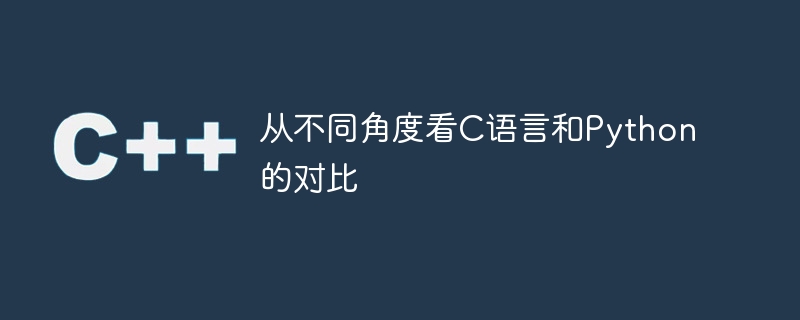Home >Backend Development >C++ >Look at the comparison between C language and Python from different angles

C language and Python are two common programming languages, each with its own characteristics and advantages. This article will compare these two languages from different perspectives and analyze their applicability, advantages and disadvantages in different scenarios.
1. Syntax simplicity
C language is a low-level language with relatively cumbersome syntax, requiring manual memory management, variable declaration, etc. For example, to write a simple Hello World program, the C language code is as follows:
#include <stdio.h>
int main() {
printf("Hello, World!");
return 0;
}Python has a concise syntax, and there is no need to declare variable types, etc. The Hello World program code is as follows:
print("Hello, World!")You can see As you can see, Python has less code and is more readable, while C language is more verbose.
2. Execution efficiency
Since C language is a compiled language and Python is an interpreted language, C language is usually more efficient than Python in terms of execution efficiency. fast. For example, let's compare a simple loop calculation code, implemented in C language and Python respectively:
#include <stdio.h>
int main() {
int sum = 0;
for (int i = 1; i <= 1000000; i ) {
sum = i;
}
printf("Sum: %d
", sum);
return 0;
}sum = 0
for i in range(1, 1000001):
sum = i
print("Sum: ", sum)Through testing, it can be found that the efficiency of C language is significantly higher than that of Python when performing large-scale loop calculations.
3. Application fields
C language is often used in systems programming, embedded development and other fields, in scenarios with high performance and resource requirements. Python is suitable for data analysis, artificial intelligence, network programming and other fields, and has a rich library and ecosystem. Take creating a simple web server as an example to compare the code implementations of C language and Python:
#include <stdio.h>
#include <sys/socket.h>
#include <netinet/in.h>
int main() {
int server_fd, new_socket;
struct sockaddr_in address;
int addrlen = sizeof(address);
server_fd = socket(AF_INET, SOCK_STREAM, 0);
address.sin_family = AF_INET;
address.sin_addr.s_addr = INADDR_ANY;
address.sin_port = htons(8080);
bind(server_fd, (struct sockaddr *)&address, sizeof(address));
listen(server_fd, 3);
new_socket = accept(server_fd, (struct sockaddr *)&address, (socklen_t*)&addrlen);
}import socket
server = socket.socket(socket.AF_INET, socket.SOCK_STREAM)
server.bind(('0.0.0.0', 8080))
server.listen(5)
while True:
client_socket, address = server.accept()As you can see, the Python code is concise and clear, with less code and is suitable for rapid development and prototype verification.
Conclusion
In summary, C language is suitable for scenarios with high performance requirements and low-level detail control, while Python is suitable for rapid development, concise and clear scenarios. . When choosing a programming language, you need to weigh the advantages and disadvantages of both according to specific needs and choose the appropriate tool to complete the task.
The above is the detailed content of Look at the comparison between C language and Python from different angles. For more information, please follow other related articles on the PHP Chinese website!